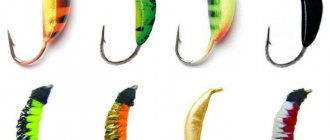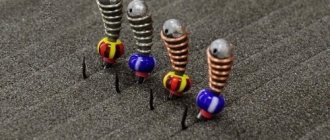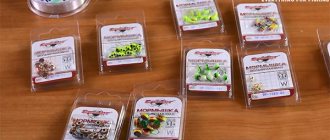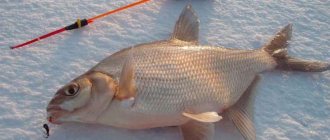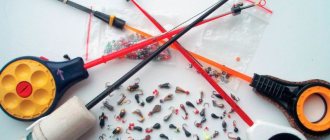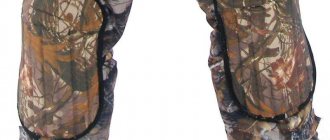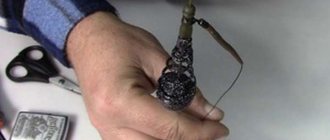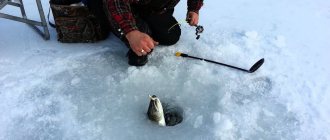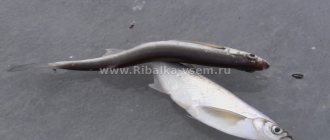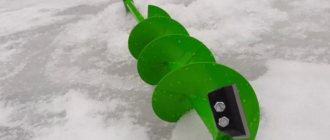With reelless jigs, controlled by nods of various designs, everyone who is not too lazy catches or tries to catch fish.
True, for some reason some fishermen call reelless baits baitless, although they themselves necessarily attach some beads and other artificial baits to the forend of the jig hooks. So, reelless jigs definitely cannot be called nozzle-less jigs.
Although it was possible to catch perch with reelless jigs without any artificial or natural baits on the hooks. But the homemade ones were made in a special formation, and the baitless baits had to be set to an exorbitant oscillation frequency with a side pendulum nod.
And in the process of catching fish with a reelless jig, I would give the well-deserved leading role to a high-quality homemade nod.
Samples of my homemade reelless jigs of different constructions are shown in the photo under the topic title. As for the construction of high-quality nod springs, material is given below in the text.
Build a reelless jig
All reelless (no-attachment) jigs, both self-made and purchased jigs, can be divided into two main classes according to their structure: horizontal and vertical reelless baits.
An example of a homemade horizontal jig without a reel is shown in the photograph. In its pure form, vertical reelless baits include baits called “devil” or “bulda”.
Between these two classes, the structure of “no-attachment” jigs can be anything. We should not just forget that any artificial bait on the hook can change the vibrations of any reelless jig in the water beyond recognition.
Next about the main thing.
The main condition for successful fishing with a reelless bait is very little. To do this, a nozzle-free jig should only be made to vibrate at a resting point with a high frequency with a minimum amplitude of vibration.
This work should be done by the nod spring. True, not every nod shock absorber design can cope with such a task.
For this reason, I have my own selfish interest in advertising the nods of my own invention and manufacture, for greater persuasiveness, by filming a couple of videos showing homemade reelless jigs of different constructions in action.
The date of manufacture of the first such nods, as well as homemade reelless jigs, falls approximately in the mid-seventies of the last century.
Nod for a reelless jig
Having gone through a couple of dozen designs of nods with springs made of various materials and tested them when fishing with various reelless jigs, back in the days of decaying socialism I settled on shock absorbers with springs made of elastic steel plates, which I still use to catch fish.
When acquiring certain skills, you can set oscillations with a frequency of more than 300-350 times per minute by nodding the spring action of jigs when fishing without bloodworm attachments. But at the same time, the hand still noticeably gets tired.
Therefore, almost simultaneously with spring ones, nods of a completely different design were invented and a different way of catching fish without bloodworms with jigs that were small in volume and weight.
To create high-frequency oscillations, a self-made pendulum nod from the clock spring of a wristwatch is more suitable.
The homemade nod shown in the photo is convenient for fishing during periods of fish feeding with a short pause between fish bites. The weight of the catch will quickly accumulate due to the saved time required to plant the bloodworms.
High-frequency vibrations of the nod spring
After selecting a nod, I suggest watching a short video showing in frames the vibrations of homemade reelless jigs under the control of a spring system, made with your own hands from a clock spring.
In principle, there is nothing unusual in the oscillations of homemade rewinders. This is exactly how reelless jigs should vibrate under winter fishing conditions in a section of a reservoir without a current.
But I want to draw your attention to the difference in the huge swing amplitude of the spring of a homemade nod and the minimal deviations from the state of rest of homemade reelless jigs
Below in the text I will embed another video for contrast, where the nod spring will be placed in the forward direction and oscillate with minimal amplitude values. But you are unlikely to notice the difference between the high-frequency vibrations of reelless jigs in both videos.
Methods for making jigs at home
Making jigs with your own hands for winter fishing enthusiasts is an activity more for the soul than for the wallet.
There are several ways to make it at home:
- sawing is the easiest way. Rods and tubes from various non-ferrous metals are sawn into small pieces. Then the hooks are soldered, processed, cleaned, and painted;
- forging. Lead is suitable, a sample is made using a hammer and anvil. Further processing is carried out with a file, the hook is soldered;
- soldering - a shape similar to a jig is made from thin colored plates. A hook is inserted and soldered inside. This entire shape is processed with a soldering iron. Here you just need to turn on your imagination.
- Good baits are made from colored wire, which is twisted into a spiral. An important element after soldering is processing with sandpaper and a felt wheel until it begins to glow “silver” or “gold”;
- casting - this technology for making jigs at home is the most complex. Only tin and lead are used. All work begins with preparing a mold for pouring molten metal. Clay, brick, sand, wood are used. First prepare the mold in this material. Be sure to cut grooves along the edges of the mold to allow air to escape when pouring. The molten metal is poured into a mold, cooled, removed, and processed with metalworking tools.
Read Fishing for pike perch with live bait
Casting jigs in sand
To begin with, select fine dry sand; it is better not to dig it up or pour it over. A mold is made from wood or other material and carefully pressed into the sand. This is filled with molten metal. At the same time, insert the hook, then process the frozen form.
Casting in wooden blocks
Wooden forms are short-lived, so you can have time to make several baits. To make round baits, you will need two wooden blocks with already prepared notches. They need to be knocked down with small nails so that these molds match. Pour molten metal through the hole made in the end, not forgetting to insert the hook. All that remains is to process the almost finished product.
Painting and decorating jigs
Fish can see colors. The color of different baits plays a role. Most fish see small objects at a distance of a meter. And trout and asp notice moving objects from a decent distance.
Roaches love black and white. Perch - red, black. This appears to be related to the fish's food database.
To color jigs, they need to be prepared. Sand, degrease with acetone or gasoline. Then they paint with different nitro paints, preferably several times - this is the fisherman’s taste.
Video: Homemade reelless jigs
Continuing the topic, watch a short video showing the vibrations of homemade reelless lead jigs of different classes under the control of a side nod. And first, pay attention to how the shock absorber spring swings from right to left when the shock absorbers themselves oscillate in the vertical plane. That is, from top to bottom.
In addition, watch the same video again and pay attention to the frequency and amplitude of vibration of the nod spring, which is at least 100 mm. At the same time, reelless homemade jigs with artificial baits on the hooks are practically in a state of vibration near the resting point.
If you appreciate what is shown in the video and you are satisfied with the frequency and amplitude of vibrations of reelless jigs of different classes under the control of the nod of the spring system, then I suggest making similar shock absorbers with your own hands.
Nod for controlling reelless jigs
The picture shows a homemade universal nod, the spring of which can be placed in the forward and lateral directions. Approximately the same shock-absorbing device was used to control reelless jigs. To help you, the materials on the topic Homemade nods for winter and summer fishing.
In order for the nasal end of a homemade reelless jig with a volumetric artificial nozzle to be in a state of vibration, the spring of the fishing nod must be set to continuous vibrations with a frequency of at least 2.5-3 hundred times per minute.
Read about the methods of catching fish with reelless jigs under the control of the nod spring of the spring action below in the test.
Making winter jigs
In developed countries, a thing made for yourself with your own hands ( DIY , an abbreviation for “do-it-yourself”) has greater value than something purchased in a store. Because a person, when involved in the process of making something, invests in it not only his own time and money, but also something more, which then certainly brings excellent results. For professionals in fishing and fishing sports, making fishing tackle with your own hands is not only pleasant, but sometimes simply necessary.
In addition, you can make your own jig that you cannot buy anywhere. Masters bring their creations to perfection, which, however, has no limits...
Conventionally, homemade jigs can be divided according to manufacturing methods: casting, soldering, and instrumental method.
Jigs are made from lead and lead-tin alloys by casting. Soldering , jigs made of tin and its alloys with lead. Instrumentally , jigs are made from tungsten, a heavy, very hard and refractory metal.
Tungsten jigs are very difficult to make at home, or rather, impossible without the necessary machines and tools, so we will not consider this manufacturing method today.
The most creative process for making jigs is soldering. Jigs made in this way are never exactly alike, and therefore the game of each such jig is original and unique. Out of a dozen soldered jigs, there is always a favorite that catches fish better than others.
This is also the main disadvantage of homemade jigs - if the jig was not made according to a template, it will be very difficult to repeat the result. Of course, this applies not only to jigs, but also to homemade baits in general - spinners, balancers, etc.
Making jigs at home
It’s easier to show than to explain how this is done, and we found a suitable video on this topic.
Making jigs by soldering:
The video and the resulting jigs are far from ideal, but that doesn’t matter. The main thing is that the very principle of making jigs in this way becomes clear. As for the jigs from the video, its author uses too large and inappropriate hooks + rough work.
Much of the production of reelless jigs is clarified in the film by the Shcherbakov brothers - Rewindless jigs
The method of making jigs by casting is the easiest, and at the same time the most difficult. The difficulty lies in making a mold for casting, which is not always possible to make at home. However, you can purchase it or order it from a familiar locksmith. This refers to a metal form made of aluminum or its alloys. Forms made of plaster or liquid glass (stationery glue) can be made at home, but they are not durable.
Gypsum forms become stronger if the gypsum is mixed with special solutions: 3-5% solution of wood glue; 2-3% borax solution; 5-6% sugar solution.
More durable in comparison with plaster, forms are obtained based on stationery or PVA glue . To do this, talc or kaolin is mixed with one of the glues until the consistency of sour cream. Forms based on these adhesives take several days to dry.
Naturally, to make molds , you need to have a model , a prototype of the jig.
For injection molds made of plaster or glue, this can be a ready-made, catchable jig for cloning, or your own model, which is usually formed from wood or waxy materials. For aluminum molds, the model must be made of hardened metal. Because such forms are made by squeezing the model between two aluminum plates.
Mold for casting jigs: 1 - sprue; 2 - aluminum plates; 3 - needle; 4 - hook.
We won’t go into the intricacies of the technology, because anyone who wants to make such injection molds for themselves most likely already knows how.
There is also a method for making jigs by winding copper or tungsten wire around the fore-end of a curved hook, followed by tinning it using solder. But such jigs, with equal sizes, are usually lighter than solid ones. However, wrapping a solid tungsten billet with wire to improve performance properties is a completely acceptable solution.
Wrapping the jig: 1 - blank; 2 - hook; 3 - wire winding; 4 - finished jig; 5 - jig with a three-dimensional pattern.
Vibrations of the nozzle on the jig hook
By construction, reelless jigs are multi-circuit baits. Each foreign link of an artificial bait added to the hook is capable of creating its own vibrations, which add up to the vibrations of the supporting body of the reelless jig.
But the role of cambrics, beads, wings and various other artificial baits on the hooks of reelless jigs is not only to create vibrations perceived by the fish.
Among other things, artificial baits significantly minimize the amplitude of vibration of the hook in relation to the rear end of the so-called “nozzleless” jig.
To confirm the statement, I am embedding another video with the vibrations of lead reelless jigs shown in the frames under the control of a homemade “straight” nod.
Video: Oscillations of a reelless jig
To compare the vibrations, I chose the same homemade reelless jigs shown in the video you have already watched, only I turned the spring of the homemade nod from a lateral position to a straight position.
Therefore, it will be natural that in this video you will see completely different vibrations of the shock absorber clock spring. And see for yourself how homemade reelless jigs will fluctuate.
Next, for novice fishermen, apparently, it is necessary to explain the essence of the attractiveness of a reelless jig and how the vibrations of homemade reelless jigs shown in the video should affect the behavior of the fish.
The influence of a nod on the oscillations of a reelless jig
The photo on the left is one of my homemade reelless jigs with a light, bulky artificial bait on the hook.
Let's assume that some half-cycle of oscillation corresponds to the gradual bending of the nod shock absorber spring in the downward direction. Naturally, an obedient reelless jig will also begin to move lower, tracking the vibration of the spring, but different parts of the bait’s body will be able to do this in different ways.
The rear (heavy) part of the reelless jig, with the center of gravity of the reelless jig located nearby, will respond more quickly to the vibration of the nod spring. When slack appears on the line, it will simply attempt to fall to the bottom.
The hook end of a homemade reelless jig with a bead that has about zero buoyancy will react much more slowly to the oscillation of the nod spring. It will try to leave this light part of the bait in the same place where it was before; the density of the water is considerable for its meager weight in the water.
From the outside, the effect of the nod will look like a collapse of the rear of a reelless jig with a slight lowering of the hook end. Or, like a vertical turn of a part of the body of a jig around an axis of rotation located near an artificial nozzle.
The pendulum of a kettlebell clock works exactly the same way. Just not in the horizontal, but in the vertical plane. And these same repeating processes of oscillation of reelless jigs are quite clearly visible in the video frames.
In the next half-cycle of high-frequency oscillations, corresponding to the upward bending of the metal spring of the homemade nod, everything will happen exactly the opposite.
The line will most quickly pull up the section of the jig located at the suspension point, while the rise of a light, volumetric artificial bait located on a hook without a reel will be significantly slowed down by the considerable density of the water.
As a result of the influence of the spring of a homemade nod on the oscillation process, we have: a sweeping swing of the rear end of the body of the reelless jig when vibrating near the resting state of the bait hook. This is largely influenced by the artificial bait on the hook of the rewinder.
Review of the best nozzle jigs
Almost all reelless baits are capable of demonstrating incredible efficiency. However, some of them deserve special attention, because they work in any conditions and attract any prey. So, the list of the most catchy nozzle jigs consists of the following models:
- "Uralochka". It is considered the most universal bait, which is used both with and without bait. An extensive selection of colors allows the angler to find the best option for specific conditions. If we talk about the most popular colors, then they include black and tungsten colors, although other shades are not worse at all. Here it is important to take into account the nature of the reservoir, namely the color of the water, the time of day when fishing occurs, as well as the weather. According to experienced fishermen, “Uralochka” perfectly attracts bream and other fish.
- "Nymph". It is a classic product that has a modified shape and is equipped with additional cambrics or beads that resemble the wings of a drowned insect. The design features of the model are built in such a way that one part of the jig remains stationary, while the other creates beautiful movements. There are various modifications of Nymph available on the market, but the classic version has a yellow and black body.
- "Goat". In terms of its design characteristics, the “goat” (or kozulka) resembles the previous jig. When you first get acquainted with the product, you get the impression that its design is inverted relative to the hook. The product exhibits specific vibrations that especially attract large roaches.
Artificial nozzles for reelless jigs
The picture shows hand-made artificial nozzles for reelless jigs, which have approximately zero buoyancy in the water. This means that homemade beads, just as they reluctantly sink, will not even think of floating up of their own free will.
Artificial baits hung on the hooks of reelless jigs can have both clearly negative buoyancy and metal ones; and capable of lifting the hook high in the aquatic environment.
Beads cut from foam plastic have pronounced positive buoyancy; Plastic masses have buoyancy close to zero. Lightweight homemade artificial attachments are also cambrics cut from wire braids.
Artificial baits made of glass beads are the same river sand, which sinks well, not much inferior in the speed of sinking to the bottom of the most reelless jig.
Artificial bait on the hook of a reelless jig
The hooks of the vast majority of reelless jigs are equipped with artificial attachments: various kinds of wings, voluminous beads, sets of beads, cambrics, simply knots of woolen thread, etc., which can slide along the underhook of the hook or be permanently attached to it.
As already mentioned, 99 percent of the fishermen who came to this page from any search service for the request “nozzle-less jigs” probably meant not nozzle-less jigs, but reelless jigs.
Because fishing with a winter fishing rod equipped with a baitless jig with a “bare” hook may not be very effective, to put it mildly. Let me explain what's going on here.
The role of artificial bait for fish
Some fishermen, placing various kinds of homemade artificial baits on the hooks of their jigs instead of bloodworms, believe that a bright bead, say, can attract the attention of fish.
And the fish, indeed, sucks the hook with an artificial nozzle, although for a different reason. But the fisherman gains confidence that he did everything right, and this is already half the success.
Other fishing enthusiasts, having a correct understanding of the vibrations created by a reelless jig, place artificial baits on hooks intelligently, selecting them according to certain parameters.
It turns out that in order to effectively catch fish with his winter fishing rods, a fisherman should think not only about the color of the baits, but also about their specific gravity (buoyancy), volume and shape.
Artificial baits can be placed on the shank of the hook either in a stationary version, pressing them with an elastic band to the body of the reelless "Uralka", or in a sliding version along the shank of the hook.
A few words about making your own artificial baits for reelless jigs, shown in the photo under the title of the article.
Homemade baits
There is a huge assortment of jigs on sale, but still every self-respecting fisherman fishes with his own baitless jigs, the most catchy ones. He makes them himself or refines an already purchased version and is rightfully proud of his products. The smallest detail can affect catchability. Therefore, the fisherman thinks out his best jigs himself. Many keep the production secret, while others share their homemade products. Therefore, nozzle-free jigs that are made by hand are very much appreciated.
Everyone tries to make the jig smaller, and this must be done masterfully so that it is not too light. Each copy has its own author.
"Universal dolphin"
Author A.Nogateev. Any fish, especially perch, bites on this bait. A removable replant is used, which allows you to use any set. For such a jig, it is better to use a fishing rod with a short whip. This jig should move widely. The ring is offset from the center of gravity. The fishing line is tied with a loop, which allows the bait to move more freely. The technique of playing with such a bait is fast retrieval with a small amplitude and high frequency.
"Universal dolphin"
"Owl"
It is made from plates of copper, brass, cupronickel. First, the workpiece is cut out, then the upper part is bent and a “groove” is made. The wire is twisted into a loop and inserted into the groove. The hook is attached using tin. With tin you need to slightly increase the body of the jig, but so that it is not thick. The jig should be light and stiff. We wash the jig with baking soda to remove the acid used for soldering. Then you need to paint it. There is no need to weigh it down too much. This bait has pronounced body vibrations. You need to play this jig aggressively.
Jigs "Owl"
"Devil"
You can make your own “devil”. To do this, you need to make hooks and wrap them with wire. Watch how this is done in the video:
Homemade artificial jig baits
I’ll share my experience on how you can make artificial baits for reelless jigs with your own hands at home.
Almost all of the attachments shown in the photo are made in a very primitive and rather unproductive way from the plastic bodies of old fountain pens. To make wings with your own hands, let's say you will need side cutters and an awl with a thin round blade.
For a long time, I simply broke the plastic with side cutters into uneven plates and pierced holes in them with a heated awl. Then he put several blanks of nozzles on the awl blade and melted the plastic over the flame of the gas stove burner.
Perhaps, when making an artificial nozzle in the form of beads in a heated state of plastic with your own hands, you will need the help of a knife blade.
I give priorities for attachments to reelless jigs either to thin “wings” with holes offset from the geometric center, or to voluminous artificial attachments in the form of beads.
Manufacturing methods
Making jigs at home is possible in several ways. Some are a very complex process, others do not require much effort and time:
- Sawing. The simplest option, for which you need to have a file, a vice and a workpiece made of the required material. The body of the jig of a given shape is cut out of a piece of metal, a hook is soldered to it and a hole is drilled for attachment to the fishing line. All that remains is to clean and coat the bait with the desired color.
- Forging. Used for lead jigs. Using a hammer on an anvil, we process the workpiece, giving it the required thickness. Then we cut out the body of the jig with a file, then solder the hook and, if necessary, cover the bait.
- Soldering. Used for jigs made of non-ferrous metals. It involves first cutting out the crown of the bait, which is bent into the required shape. Then the resulting void is filled with solder and the hook is fixed with it.
Photo 1. Soldered jig.
Photo 2. Cast jig.
These are the main options for making jigs with your own hands. There are also original and simple ways. We'll talk about some of them below.
DIY reelless jigs
You can learn the intricacies of making windless jigs with your own hands by filling the crowns with solder or lead by clicking on the link at the bottom of the article.
True, there are tips on how to make ordinary jigs with your own hands, intended for catching fish with baits of natural origin, which, given the specifics of this topic, need minor additions.
When making jigs designed for reelless fishing with your own hands, it is advisable to solder hooks with a long shank into the bait in order to place various oscillatory elements on them.
Reelless jigs with a significant inclination of the longitudinal axes are considered more attractive to fish. Such a structure can be achieved by shifting the opening of the hole for passing the fishing line closer to its rear part during the process of making the bait yourself. Using the same principle, you can convert an ordinary bait into a reelless jig with your own hands.
You can make the basics of homemade reelless jigs of different constructions using the tips in the article Do-it-yourself jigs.
Fishing with a homemade jig without bloodworms
Currently, not such a small part of fishermen are engaged in fishing with winter fishing rods using jigs without bloodworms.
This is understandable. When fishing with jigs that do not require constant updating of the bloodworm bait, a significant portion of the time of a short winter day is saved.
This means that more of it is left for guiding reelless jigs, which, naturally, affects the overall efficiency of the fish catch.
True, many fishermen, it turns out, also fish with baitless jigs (judging by their name on numerous sites). That is, for baits whose hooks are devoid not only of bloodworms, but also of any artificial baits. For which we can congratulate them.
Although it seems that the art of fishing with a reelless jig consists precisely in the correct selection of an artificial bait for a “nozzleless” jig instead of a bloodworm. And not only.
For effective fishing with jigs without bloodworms, it is necessary to create vibrations with a nod of such a frequency that the artificial baits on the hooks of the jigs would not have time to deviate too noticeably from the position they occupy in the water at rest.
It is precisely these properties of reelless jigs with artificial attachments on hooks at high frequency vibrations created by the nod spring that the material on this topic was devoted to.
